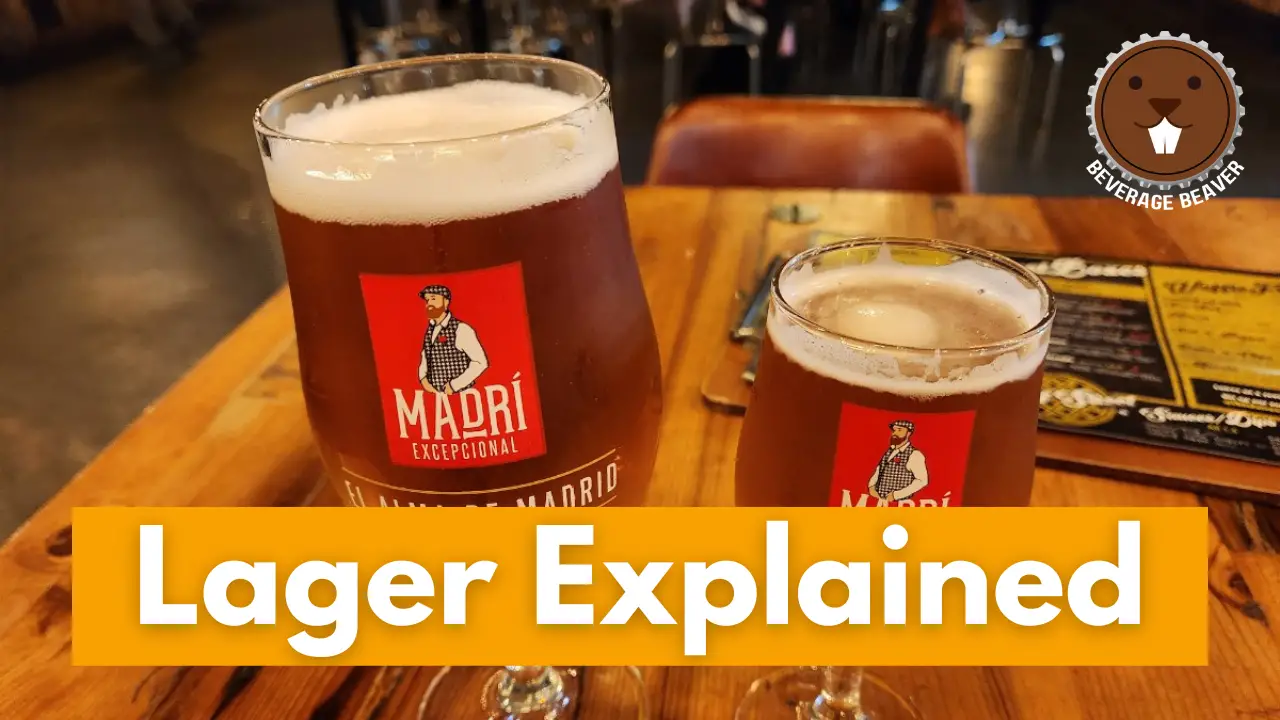Lager Explained: What Is It And How Does It Compare To Other Beer Styles
When people order a lager in a bar or a pub, they are usually expecting to receive a beer like Stella Artois or Heineken. These beers are actually ‘pale lagers,’ and the term ‘lager’ in fact refers to a whole category of beers that includes a variety of styles from lighter ones like pale lagers and pilsners to darker ones like Dunkels and Baltic porters. In this guide, you’ll learn what lager is, how it’s brewed, the different types of lager, and how lager compares to other popular beer styles.
What Is Lager?
Generally speaking, there are two main categories of beer: Lager and Ale. Lagers are beers brewed at cooler temperatures using bottom-fermenting yeast and are cold-stored for an extended period of time.
The term ‘lager’ comes from the German word ‘lagern,’ which means ‘to store.’ This is a reference to the ‘lagering’ method of aging beer at cold temperatures to develop flavors.
Unlike ales, lagers are brewed and stored at cooler temperatures for longer periods, typically at 45-55°F (7-13°C), resulting in a cleaner, crisper taste without the fruity esters common in ales.
How Is Lager Brewed?
Here’s a general overview of how lager beer is brewed. While different breweries and brewers may add their own unique touches, these fundamental steps in the brewing process remain largely the same when brewing lager.
Step 1: Milling
The brewing process starts with milling. Here, malted barley (and sometimes other grains) is processed to break down the kernels, exposing the starchy center crucial for the next step.
Step 2: Mashing
The milled grains are transferred to a mash tun, where they’re combined with hot water. This stage, known as mashing, converts the grain starches into fermentable sugars, setting the stage for fermentation.
Step 3: Lautering
After mashing, the mixture undergoes lautering. This process involves separating the liquid portion, now called ‘wort,’ from the solid grain material, ensuring that the brewer can extract as much liquid as possible.
Step 4: Boiling
The wort is then boiled. This sterilizes the wort and eliminates any potential contaminants. At this stage, hops are introduced, which contribute to the bitterness, flavor, and aroma of the beer.
Step 5: Fermentation
Once the wort is boiled and cooled, it’s moved to a fermentation vessel, and yeast is introduced. Due to lagers using bottom-fermenting yeast, fermentation occurs at cooler temperatures, usually between 45-55°F (7-13°C), giving lagers their signature clean and crisp characteristics.
Step 6: Lagering
Post-fermentation, lager beers aren’t immediately ready for consumption. They undergo a cold storage period, known as lagering, at temperatures close to freezing and for several weeks or months. This process allows the beer to mature, which develops and stabilizes the flavors.
Step 7: Filtering and Carbonating
After lagering, the beer is usually filtered to eliminate sediment, presenting a cleaner appearance and taste. It’s then carbonated, either through natural methods or forced carbonation.
Step 8: Packaging
Finally, the lager is packaged into bottles, cans, kegs, or casks, ready for distribution and consumption.
List Of Different Kinds Of Lager
As I mentioned earlier, there are many different styles of lager that fall under the lager category of beers. Here’s a list of the different types of lager.
Pilsner (or Pils)
Originating from the Czech Republic, this pale lager is light and crisp, with noticeable hop bitterness. German-style Pilsners tend to be more bitter, while Czech Pilsners are often more balanced. Learn More About Pilsners.
Helles
A traditional German-style pale lager, Helles is malt-forward with underlying hop bitterness, offering a smooth and balanced drink. One of my favorite Helles lagers is Paulaner Munich Hell.
Dunkel
Also hailing from Germany, Dunkels are smooth, rich, and complex without being overly heavy. They’re characterized by their dark color and malty flavor. A good example of this style of lager is Erdinger Dunkel.
Bock
A strong lager from Germany, Bocks are smooth, rich, and sweet, with a higher alcohol content than typical lagers and minimal hop bitterness. Shiner Bock is a good example of a bock-style lager.
Doppelbock
An even stronger version of the traditional Bock, Doppelbocks are full-bodied, with a significant malty sweetness. If you want to try a doppelbock, check out Ayinger Celebrator.
Märzen
Known outside Germany as Oktoberfest beer, Märzens are full-bodied, rich, and toasty. They’re typically brewed in the spring and left to mature until fall. Paulaner Oktoberfest Märzen is a good example of this style of lager.
Schwarzbier
Literally meaning “black beer” in German, Schwarzbiers are dark in color with a chocolatey, roasted flavor profile, yet they maintain a light and crisp texture. Köstritzer Schwarzbier is a good example of this style.
Vienna Lager
Originating in Vienna, this amber-colored lager presents a balanced profile of sweet maltiness and subtle hop bitterness. Samuel Adams Boston Lager is a decent Vienna-style lager.
American Light Lager
Known for their light flavor and low alcohol content, these lagers are heavily carbonated and extremely light in both malt and hop character. Bud Light is a perfect example of an American Light Lager.
American Lager
A standard mass-market lager, it’s fuller than the light lager but remains mild in flavor with a clean, crisp taste. Budweiser is the obvious quintessential American lager.
Baltic Porter
Despite the name, this is indeed a lager. Stronger and richer than most traditional lagers, Baltic Porters are brewed in the Baltic Sea region and feature significant malt depth and alcohol warmth.
International Pale Lager
This category encompasses various mass-market pale lagers globally, known for being light, easy-drinking, and mild in flavor. Corona Extra is one such example of this style of lager.
Adjunct Lager
These are typically American, mass-produced lagers that use adjuncts like rice or corn to lighten both the flavor and body of the beer. An example of this style is Miller High Life.
Lager Compared To Other Beer Styles
Lager vs IPA
IPAs are hugely popular these days. In fact, I can’t remember the last time I went to a bar and they didn’t have at least one IPA on tap! So, what are IPAs, and how do they differ from lagers?
IPAs, or India Pale Ales, are a beer style known for their pronounced hop bitterness, complex aromas, and higher alcohol content. As an ale, IPAs are brewed at warmer temperatures using top-fermenting yeast, leading to a fruitier, more robust flavor profile. Lagers, on the other hand, are fermented and stored at cooler temperatures with bottom-fermenting yeast, producing cleaner, crisper tastes with subdued fruitiness.
Compared to lagers, IPAs are more flavorful, with a distinctive hop-forward character that delivers a significant bitter kick. While lagers are known for being refreshing and highly drinkable, IPAs appeal to those who prefer a more intense, flavorful beer with a higher alcohol content. For those who enjoy the drinkability of lager but crave the intense flavor of IPAs, session IPAs provide a great compromise. These typically have a lower alcohol percentage, allowing one to enjoy them over a longer ‘session’ without becoming overly inebriated.
Lager vs Kolsch
Kolsch is an interesting beer style as it doesn’t follow the typical brewing processes of lagers or ales. In fact, it combines the two as it uses top-fermenting yeast (ale yeast) and is brewed and lagered (stored) at cooler temperatures. This creates a ‘lagered ale’ which tastes like a slightly fruity ale with a crisp, clean finish, and looks like a typical pale lager with its clear, bright straw-yellow hue.
Compared to pale lagers, Kolsch is slightly more aromatic and fruity due to the ale yeast, but it maintains a similar refreshing lightness and high carbonation. The unique brewing process gives Kolsch the best of both worlds: the fruity notes of an ale and the crisp, mellow finish of a lager. Its moderate hop bitterness and light body make it an excellent choice for those who appreciate the characteristics of both ales and lagers.
Lager vs Amber Ales
Amber ales are characterized by their deep amber color and their robust flavor profiles. Unlike lagers that are brewed with bottom-fermenting yeast at cooler temperatures, amber ales are brewed with top-fermenting yeast at warmer temperatures. This results in a fruitier and more robust flavor with a higher hop presence.
In terms of mouthfeel, amber ales typically present a fuller, richer experience, often with a smooth or slightly creamy texture that complements their complex malt profile and pronounced flavors. The body of an amber ale tends to be medium to full, providing a substantial feel that supports the diverse array of tasting notes.
Lagers, on the other hand, with their cold fermentation process and crisp finish, offer a cleaner, more refreshing mouthfeel. They are generally lighter and highly carbonated, leading to a sharp, effervescent sensation on the palate.

